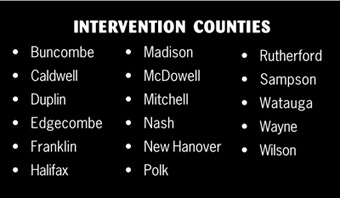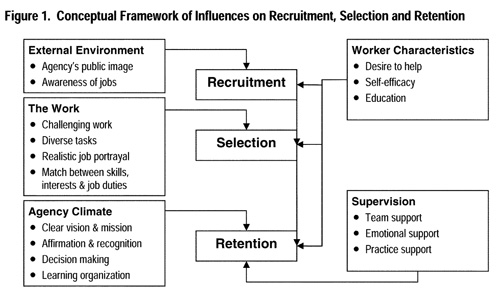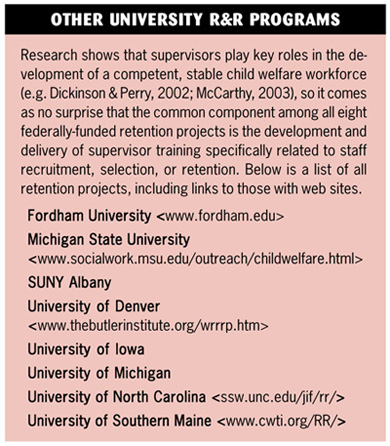 |
 |
 |
©
2007 Jordan Institute
for Families

Vol.
12, No. 1
January 2007
NC's Recruitment and Retention Project
by Nancy Dickinson, PhD
The continued loss of qualified and committed child welfare workers has a significant and detrimental effect on child welfare agencies and on the families and children they serve. To help address this serious problem, in 2003 the US Children’s Bureau awarded 5-year grants to eight universities to undertake projects to increase the ability of public child welfare agencies to retain qualified child welfare workers.
The Jordan Institute for Families at the UNC–Chapel Hill School of Social Work received one of these grants. I have the good fortune of being the principal investigator (lead researcher) for this project. Our project is called “Child Welfare Staff Recruitment and Retention: An Evidence-Based Training Model,” though in this article we will refer to it simply as North Carolina’s R&R project.
Though our work is still in progress, I thought you would be interested in what we are doing, what we have learned so far, and how we anticipate our efforts will eventually benefit you and your agency.
North Carolina’s R&R Project
In an effort to improve the recruitment, selection, and retention of child welfare workers, we are developing and testing a model of workforce development. Our goal is to create resources that will help public child welfare directors and supervisors increase their ability to recruit, select, and retain a qualified and committed team of workers who understand and are prepared for child welfare work.
Project Design
North Carolina’s R&R project employs an experimental design. Thirty-four North Carolina county departments of social services were randomly chosen to participate and then randomly assigned to intervention or comparison groups. The intervention counties are receiving supervisor training, directors’ seminars, technical assistance and recruitment and selection resources.

Both intervention and comparison counties are keeping records of child welfare worker turnover information, and all project counties are participating in periodic worker surveys. In fall 2008, when the project concludes, comparisons will be made between the two groups of project counties on recruitment, selection, and retention factors.
Conceptual Framework
This project’s activities are based on a conceptual framework that holds that attention to recruitment, selection, and retention—all three—is necessary in order to have a significant impact on the child welfare workforce.
As presented in Figure 1, these three outcomes are sequentially related and yet influenced by distinct dimensions. Factors related to the external environment directly impact the ability of the agency to recruit a favorable pool of candidates for child welfare positions. The nature of the work is a category of issues that affect the ability of managers and supervisors to select qualified child welfare staff. And retention of competent and committed child welfare workers is influenced by the agency climate and supervisory characteristics. Individual worker traits influence all three outcomes: recruitment, selection, and retention.

Worker Survey Results
This conceptual framework formed the basis for a survey that has been administered three times to child welfare workers in all 34 project counties.
In June 2005, 716 child welfare workers from 33 participating county departments of social services were invited to complete a web-based survey. With a response rate of 49.5%, 356 surveys were suitable for analysis.
The survey measured workers’ perceptions about their work, supervisor, and agency, all shown in the literature to be related to intent to leave. Workers were also asked how likely they are to leave their positions within the next six months. Worker responses were defined by 16 scales designed to measure the domains of child welfare work, supervision, and the agency.
Five scales were found to be significantly related to a worker’s intention to leave his or her public child welfare job: match between skill and work, agency recognition, accurate job portrayal, supervisor’s emotional support, salary and benefits. In other words, workers responding to the survey told us that workers will likely intend to stay on the job if:
- They feel they have the skills to do the work
- The agency recognizes and rewards their contributions
- They have accurate and realistic understanding of child welfare work before accepting the position
- They feel emotionally supported by supervisors, and
- Their salary and benefits are reasonable.
These findings highlight the complex nature of child welfare worker turnover and have implications for supervisor training, recruitment and selection methods, and agency culture change efforts.
NC’s R&R Project Products
This project is committed to helping agencies retain the highest-caliber and most stable child welfare workforce possible. Our Staying Power! training modules, video, and toolkits are designed to help them do this. The following products, currently under development, will be available for general use in late 2008.
Realistic Job Preview
Prospective workers need a candid assessment of the field in order to determine whether child welfare work is a good fit for them. Our realistic job preview is a job-candidate selection tool that helps applicants make this important decision.
Behind the Scenes. Our “An Invitation to Choose” DVD features 33 minutes of on-the-job interviews with child welfare workers talking openly about both the challenges and the rewards of their work. The interviews offer a realistic overview of what it’s like “out in the trenches,” giving prospective candidates a chance to understand whether the long hours, the paperwork, and the challenges and rewards of child welfare work are right for them.
Training
NC’s R&R project has developed three training modules to equip child welfare supervisors, directors, and trainers with tools for transferring new skills to the agency. These interactive modules are designed to augment and amplify retention practices.
A Supervisor’s Guide to Retention. This three-day curriculum enhances the ability of supervisors and managers to retain qualified child welfare workers.
A Director’s Guide to Retention. This one-day seminar teaches agency directors techniques for keeping child welfare staff motivated, interested, and on the job.
Training of Trainers. The project offers assistance to child welfare trainers to help them increase their agency’s long-term capacity to improve recruitment, selection, and retention of child welfare workers.
Toolkits
Recruitment and selection toolkits are designed to help public child welfare agencies increase the number and quality of candidates for child welfare positions.
Recruitment Toolkit. The recruitment toolkit includes flyers, posters, brochures, and two public service announcements, designed for distribution to local TV stations to encourage interest in child welfare work.
Selection Toolkit. Get the right person in the right job using a three-pronged approach: a standard interview, a fact-finding interview, and a written exercise.
Technical Assistance
There’s no point in a training program without good follow-up to help you implement all you’ve learned. Technical assistance—offering ongoing consultation to improve your ability to recruit, select, and retain a qualified staff—will be made available to participating supervisors, agency directors, managers, and trainers during the final phase of the study to ensure a fluid and constant transfer of learning. When the curriculum is complete (late 2008), technical assistance will be made available to non-participating agencies.
What We Hope to Learn
A key lesson that the project hopes to demonstrate is that integrated, evidence-based resources and training curricula can significantly improve the ability of supervisors and managers to recruit, select, and retain a competent child welfare staff.
Starting with variables from the literature that impact the separate dimensions of staff recruitment, selection, and retention, the project is developing and testing a comprehensive theory of how a competent child welfare workforce is developed. The project is also demonstrating those supervisory and management practices which are amenable to training and likely to improve the quality of the agency’s workforce.
If it is successful, we believe this project could lead to policies at the county and state levels which address such factors as standardized, competency-based hiring procedures, resources for ongoing recruitment activities, organizational climate, and leadership development.
To Learn More
If you have questions about UNC-Chapel Hill’s “Child Welfare Staff Recruitment and Retention: An Evidence-Based Training Model,” please contact Nancy Dickinson, Jordan Institute for Families, UNC Chapel Hill School of Social Work, 301 Pittsboro St., CB #3550, Chapel Hill, NC 27599-3550, 919/962-6407.
